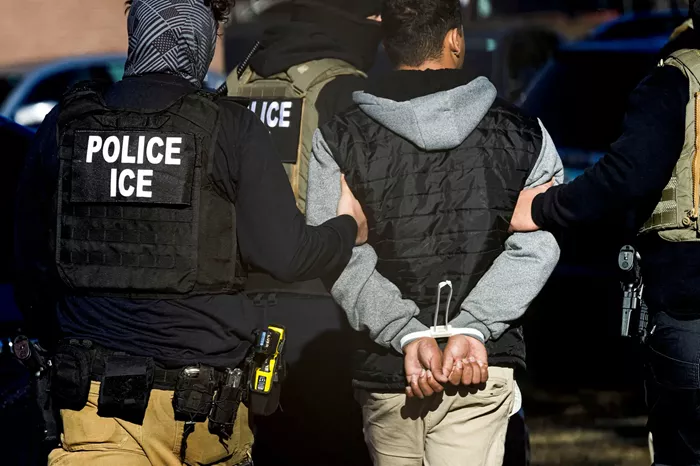The Trump administration has come under scrutiny for its increasing reliance on tattoos as a means to identify gang members, particularly in the case of Venezuelan migrants. Critics argue that this method overlooks established law enforcement protocols and may result in wrongful deportations.
One notable case occurred during the early days of the first Trump administration, when immigration agents arrested Daniel Ramirez Medina in Seattle, accusing him of being a gang member based on a tattoo on his left forearm. The tattoo, which featured a five-point star and the phrase “La Paz — BCS,” was initially used as evidence. However, Ramirez, a Mexican-born immigrant raised in California, had been living in the U.S. legally under the Deferred Action for Childhood Arrivals (DACA) program. After spending six weeks in detention, a judge ruled that the tattoo referenced Ramirez’s hometown, not gang affiliation, and he was released.
Now, under the second Trump administration, tattoos have become a central element in the government’s effort to deport Venezuelan migrants allegedly tied to the gang Tren de Aragua. This strategy, some argue, contradicts decades of law enforcement practice, where tattoos are typically just one of many indicators used to investigate gang membership.
The Role of Tattoos in Gang Investigations
Tattoos have long been a part of gang investigations but are considered secondary evidence by law enforcement. Joseph Kenny, Chief of Detectives at the New York Police Department (NYPD), emphasized that tattoos alone are insufficient to prove gang membership. “A tattoo is never sufficient evidence to prove someone is part of a criminal group,” Kenny said. “We have very strict criteria” for including individuals in the department’s gang database.
In New York, where Tren de Aragua is still a relatively new presence, tattoos have been flagged as potential symbols of allegiance. Among the tattoos associated with the gang are images of clocks, which represent time spent in prison, and symbols linked to the Venezuelan neighborhood of 23 de Enero in Caracas, often featuring references to the Chicago Bulls or their iconic player, Michael Jordan. However, law enforcement officials have noted that tattoos should never be the sole basis for criminal charges.
The Challenge of Defining Gang Affiliation
Law enforcement experts, including former correctional officer Leandro Paulino, who now leads the International Law Enforcement Officers Association, argue that while tattoos can be a helpful tool, they must be corroborated with other investigative methods. “It’s the correctional officers and confidential informants who give us the full picture,” Paulino said. “They tell us whether or not someone’s involvement is legitimate.”
Additionally, the use of tattoos in criminal trials has been limited. Prosecutors often present tattoos in court to illustrate gang affiliation, but they are rarely the deciding factor in legal outcomes. “Tattoos can be telling, but they are just one piece of a much larger puzzle,” said Ryan Brackley, an assistant district attorney in Colorado.
Questions About the Trump Administration’s Approach
The current administration has been accused of lowering the threshold for designating individuals as gang members, particularly through its use of the “Alien Enemy Validation Guide.” According to this guide, individuals can be deemed members of Tren de Aragua based on a points system, where a tattoo denoting membership can earn four points. If a person accumulates eight points, they can be deported under the Alien Enemies Act, often without the opportunity to contest the decision in court.
One recent case involved Andry Jose Hernandez Romero, a Venezuelan makeup artist, who was deported to El Salvador despite his defense team arguing that his tattoos—two crowns with “Mom” and “Dad” inscribed—had no connection to Tren de Aragua. The case has raised questions about the reliability of tattoos as a sole indicator of gang affiliation.
Legal and Ethical Concerns
Bill O. Hing, a law professor and long-time immigration attorney, criticized the government’s overreliance on tattoos, calling it a simplistic approach. “It’s overinclusive to make such a generalization,” Hing said, noting that while some gang members may have specific tattoos, not all individuals bearing similar marks are gang members.
As immigration enforcement ramps up, Hing anticipates a surge in legal challenges. “There’s an uptick in pressure for legal representation,” he explained. “ICE is busy, and people are being targeted based on assumptions that tattoos alone are enough to label them.”
The debate over the role of tattoos in identifying gang members highlights the broader challenges surrounding immigration enforcement and the potential for misidentifying individuals based on superficial markers. As more cases like Hernandez Romero’s emerge, the need for clear and fair guidelines in gang identification becomes increasingly critical.
Related topics:

